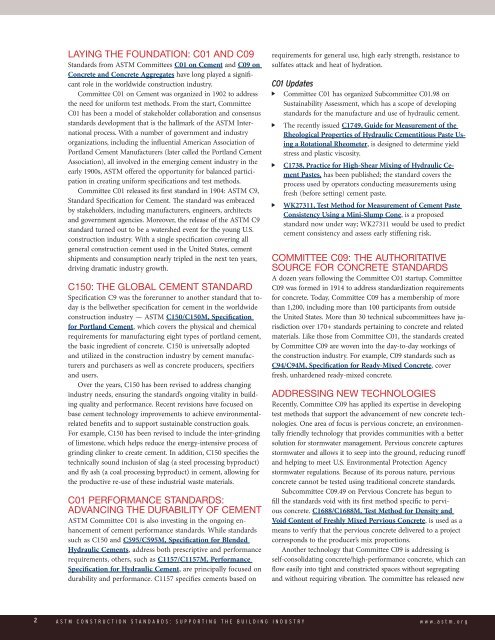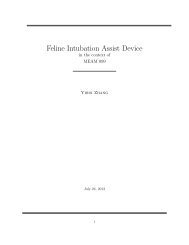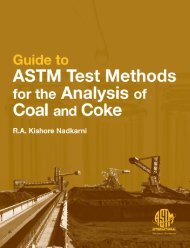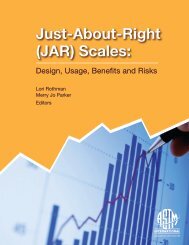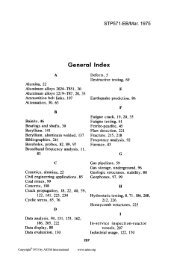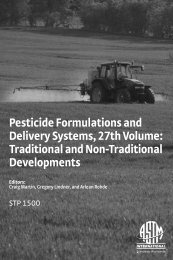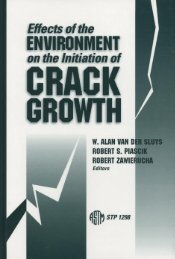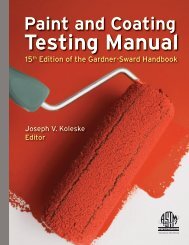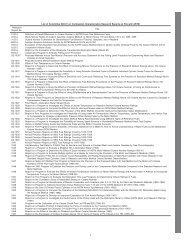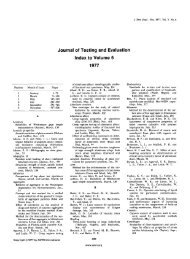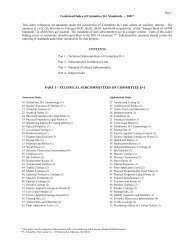ASTM Construction Standards: Supporting the Building Industry
ASTM Construction Standards: Supporting the Building Industry
ASTM Construction Standards: Supporting the Building Industry
Create successful ePaper yourself
Turn your PDF publications into a flip-book with our unique Google optimized e-Paper software.
2<br />
LAyIng The FoundATIon: C01 And C09<br />
<strong>Standards</strong> from <strong>ASTM</strong> Committees C01 on Cement and C09 on<br />
Concrete and Concrete Aggregates have long played a significant<br />
role in <strong>the</strong> worldwide construction industry.<br />
Committee C01 on Cement was organized in 1902 to address<br />
<strong>the</strong> need for uniform test methods. From <strong>the</strong> start, Committee<br />
C01 has been a model of stakeholder collaboration and consensus<br />
standards development that is <strong>the</strong> hallmark of <strong>the</strong> <strong>ASTM</strong> International<br />
process. With a number of government and industry<br />
organizations, including <strong>the</strong> influential American Association of<br />
Portland Cement Manufacturers (later called <strong>the</strong> Portland Cement<br />
Association), all involved in <strong>the</strong> emerging cement industry in <strong>the</strong><br />
early 1900s, <strong>ASTM</strong> offered <strong>the</strong> opportunity for balanced participation<br />
in creating uniform specifications and test methods.<br />
Committee C01 released its first standard in 1904: <strong>ASTM</strong> C9,<br />
Standard Specification for Cement. The standard was embraced<br />
by stakeholders, including manufacturers, engineers, architects<br />
and government agencies. Moreover, <strong>the</strong> release of <strong>the</strong> <strong>ASTM</strong> C9<br />
standard turned out to be a watershed event for <strong>the</strong> young U.S.<br />
construction industry. With a single specification covering all<br />
general construction cement used in <strong>the</strong> United States, cement<br />
shipments and consumption nearly tripled in <strong>the</strong> next ten years,<br />
driving dramatic industry growth.<br />
C150: The gLobAL CeMenT STAndArd<br />
Specification C9 was <strong>the</strong> forerunner to ano<strong>the</strong>r standard that today<br />
is <strong>the</strong> bellwe<strong>the</strong>r specification for cement in <strong>the</strong> worldwide<br />
construction industry — <strong>ASTM</strong> C150/C150M, Specification<br />
for Portland Cement, which covers <strong>the</strong> physical and chemical<br />
requirements for manufacturing eight types of portland cement,<br />
<strong>the</strong> basic ingredient of concrete. C150 is universally adopted<br />
and utilized in <strong>the</strong> construction industry by cement manufacturers<br />
and purchasers as well as concrete producers, specifiers<br />
and users.<br />
Over <strong>the</strong> years, C150 has been revised to address changing<br />
industry needs, ensuring <strong>the</strong> standard’s ongoing vitality in building<br />
quality and performance. Recent revisions have focused on<br />
base cement technology improvements to achieve environmentalrelated<br />
benefits and to support sustainable construction goals.<br />
For example, C150 has been revised to include <strong>the</strong> inter-grinding<br />
of limestone, which helps reduce <strong>the</strong> energy-intensive process of<br />
grinding clinker to create cement. In addition, C150 specifies <strong>the</strong><br />
technically sound inclusion of slag (a steel processing byproduct)<br />
and fly ash (a coal processing byproduct) in cement, allowing for<br />
<strong>the</strong> productive re-use of <strong>the</strong>se industrial waste materials.<br />
C01 PerForMAnCe STAndArdS:<br />
AdvAnCIng The durAbILITy oF CeMenT<br />
<strong>ASTM</strong> Committee C01 is also investing in <strong>the</strong> ongoing enhancement<br />
of cement performance standards. While standards<br />
such as C150 and C595/C595M, Specification for Blended<br />
Hydraulic Cements, address both prescriptive and performance<br />
requirements, o<strong>the</strong>rs, such as C1157/C1157M, Performance<br />
Specification for Hydraulic Cement, are principally focused on<br />
durability and performance. C1157 specifies cements based on<br />
requirements for general use, high early strength, resistance to<br />
sulfates attack and heat of hydration.<br />
C01 Updates<br />
k Committee C01 has organized Subcommittee C01.98 on<br />
Sustainability Assessment, which has a scope of developing<br />
standards for <strong>the</strong> manufacture and use of hydraulic cement.<br />
k The recently issued C1749, Guide for Measurement of <strong>the</strong><br />
Rheological Properties of Hydraulic Cementitious Paste Using<br />
a Rotational Rheometer, is designed to determine yield<br />
stress and plastic viscosity.<br />
k C1738, Practice for High-Shear Mixing of Hydraulic Cement<br />
Pastes, has been published; <strong>the</strong> standard covers <strong>the</strong><br />
process used by operators conducting measurements using<br />
fresh (before setting) cement paste.<br />
k WK27311, Test Method for Measurement of Cement Paste<br />
Consistency Using a Mini-Slump Cone, is a proposed<br />
standard now under way; WK27311 would be used to predict<br />
cement consistency and assess early stiffening risk.<br />
CoMMITTee C09: The AuThorITATIve<br />
SourCe For ConCreTe STAndArdS<br />
A dozen years following <strong>the</strong> Committee C01 startup, Committee<br />
C09 was formed in 1914 to address standardization requirements<br />
for concrete. Today, Committee C09 has a membership of more<br />
than 1,200, including more than 100 participants from outside<br />
<strong>the</strong> United States. More than 30 technical subcommittees have jurisdiction<br />
over 170+ standards pertaining to concrete and related<br />
materials. Like those from Committee C01, <strong>the</strong> standards created<br />
by Committee C09 are woven into <strong>the</strong> day-to-day workings of<br />
<strong>the</strong> construction industry. For example, C09 standards such as<br />
C94/C94M, Specification for Ready-Mixed Concrete, cover<br />
fresh, unhardened ready-mixed concrete.<br />
AddreSSIng new TeChnoLogIeS<br />
Recently, Committee C09 has applied its expertise in developing<br />
test methods that support <strong>the</strong> advancement of new concrete technologies.<br />
One area of focus is pervious concrete, an environmentally<br />
friendly technology that provides communities with a better<br />
solution for stormwater management. Pervious concrete captures<br />
stormwater and allows it to seep into <strong>the</strong> ground, reducing runoff<br />
and helping to meet U.S. Environmental Protection Agency<br />
stormwater regulations. Because of its porous nature, pervious<br />
concrete cannot be tested using traditional concrete standards.<br />
Subcommittee C09.49 on Pervious Concrete has begun to<br />
fill <strong>the</strong> standards void with its first method specific to pervious<br />
concrete. C1688/C1688M, Test Method for Density and<br />
Void Content of Freshly Mixed Pervious Concrete, is used as a<br />
means to verify that <strong>the</strong> pervious concrete delivered to a project<br />
corresponds to <strong>the</strong> producer’s mix proportions.<br />
Ano<strong>the</strong>r technology that Committee C09 is addressing is<br />
self-consolidating concrete/high-performance concrete, which can<br />
flow easily into tight and constricted spaces without segregating<br />
and without requiring vibration. The committee has released new<br />
<strong>ASTM</strong> ConSTruCTion STAndArdS: SupporTing The <strong>Building</strong> induSTry www.astm.org


